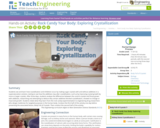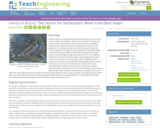
Play a game of concentration by matching terms used in the scientific method to their proper description.
- Subject:
- Mathematics
- Science
- Material Type:
- Game
- Provider:
- IXL
- Date Added:
- 12/01/2023

Play a game of concentration by matching terms used in the scientific method to their proper description.

This video segment from Nature features ravens, the most intelligent birds in the crow family. [3:00]

In this video, Monique demonstrates how to perform a restriction enzyme digest in the lab.

Many of today's popular sports are based around the use of balls, yet none of the balls are completely alike. In fact, they are all designed with specific characteristics in mind and are quite varied. Students investigate different balls' abilities to bounce and represent the data they collect graphically.

Students see and learn how crystallization and inhibition occur by making sugar crystals with and without additives in a supersaturation solution, testing to see how the additives may alter crystallization, such as by improving crystal growth by more or larger crystals. After three days, students analyze the differences between the control crystals and those grown with additives, researching and attempting to deduce why certain additives blocked crystallization, showed no change or improved growth. Students relate what they learn from the rock candy experimentation to engineering drug researchers who design medicines for targeted purposes in the human body. Conduct the first half of this activity one day before presenting the associated lesson, Body Full of Crystals. Then conduct the second half of the activity.

Given a hypothetical civil engineering scenario, student pairs are tasked to apply their knowledge of the rock cycle, rock types, rock weathering and the engineering design process to model a potential method to create a sandy beach from three rocky island shorelines. For their abrasion weathering models, they use wide-mouth lidded jars and three types of candies that serve as the testing “rocks.” They simulate both low- and high-energy weathering environments. After completing the simple weathering techniques and analyzing their observations of the results, they conclude by recommending to the island developer which rocky shoreline would be the easiest, simplest, and most cost-effective from which to create a sandy beach. A worksheet and pre/post quiz are provided.

Watch Scientist Joe as he makes the lava lamp experiment.

Use skittles to form a rainbow with this hands-on experiment. Links to video of the experiment.

How does a hand warmer warm your hands? Find out with this demonstration of the exothermic reaction of water and sodium acetate in action. [2:24]

Another Rube Goldberg machine that has some interesting back and forth surprises! [0:38]

Using food coloring, this color experiment demonstrates how dish soap and milk behave when they come into contact with each other. [2:28]

See how a simple tea bag turns into a rocket with the help of heat convection. [1:24]

Learn why photons, electric fields, silicon, and electrons are important when it comes to generating electricity from sunlight in solar panels. [1:15]

See if a vortex of condensed air can knock three different huts down. [2:33]

Watch this video and see the difference water can make as it absorbs the heat from the flame before the balloon can pop. [3:48]

This pathway introduces the scientific method as the fundamental concept of the scientific process and illustrates how scientific inquiry should be conducted.

Student teams are challenged to evaluate the design of several liquid soaps to answer the question, “Which soap is the best?” Through two simple teacher class demonstrations and the activity investigation, students learn about surface tension and how it is measured, the properties of surfactants (soaps), and how surfactants change the surface properties of liquids. As they evaluate the engineering design of real-world products (different liquid dish washing soap brands), students see the range of design constraints such as cost, reliability, effectiveness and environmental impact. By investigating the critical micelle concentration of various soaps, students determine which requires less volume to be an effective cleaning agent, factors related to both the cost and environmental impact of the surfactant. By investigating the minimum surface tension of the soap, students determine which dissolves dirt and oil most effectively and thus cleans with the least effort. Students evaluate these competing criteria and make their own determination as to which of five liquid soaps make the “best” soap, giving their own evidence and scientific reasoning. They make the connection between gathered data and the real-world experience in using these liquid soaps.

Over the course of three sessions, students act as agricultural engineers and learn about the sustainable pest control technique known as soil biosolarization in which organic waste is used to help eliminate pests during soil solarization instead of using toxic compounds like pesticides and fumigants. Student teams prepare seed starter pots using a source of microorganisms (soil or compost) and “organic waste” (such as oatmeal, a source of carbon for the microorganisms). They plant seeds (representing weed seeds) in the pots, add water and cover them with plastic wrap. At experiment end, students count the weed seedlings and assess the efficacy of the soil biosolarization technique in inactivating the weed seeds. An experiment-guiding handout and pre/post quizzes are provided.

Learn about the steps to take while performing the scientific method in an investigation. [1:31]

In this video segment from Nature, scientific experiments test how ravens think. [2:01]